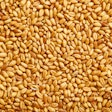
Not just for cows, but cow dogs too, sorghum has the right attributes to expand beyond traditional livestock feeding into the high margin, value-added pet food market in Mexico. A series of activities with Mexican grain buyers and pet food manufacturers, organized by the U.S. Grains Council (USGC), is sharing the ins and outs of how U.S. sorghum fits in the pet food formula.
|
Isabella Alvarenga, research graduate student at Kansas State University, presented on using sorghum in pet food at a AMEPA technical conference in Mexico. |
This week, Isabella Alvarenga, research graduate student at Kansas State University, and Tim Lust, chief executive officer of the United Sorghum Checkoff Program (USCP), shared information on the milling characteristics and inclusion considerations for sorghum’s use in pet food during a meeting of the major national feed association in Mexico, AMEPA, in Guadalajara.
Eleven mills in Mexico, concentrated in Guadalajara, produce more than 920,000 metric tons of dog and cat food annually, representing approximately three percent of all animal feed produced in Mexico. This market is small, but is high-value and would increase demand and value for sorghum overall.
“There is a niche market opportunity that can be important to the sorghum sector,” said Javier Chavez, USGC Mexico marketing specialist who has worked with buyers interested in including sorghum in pet food.
Similar to in the United States, owners who see pets as members of their families are demanding new types of food products that often follow human health trends, creating a marketing environment in which companies are constantly innovating. Sorghum is well-positioned to help meet these needs because the grain has a low glycemic index, is rich in antioxidants and has a measurable amount of dietary fiber.
As a result, the Council and USCP are looking for new market opportunities within the pet food sector for U.S. sorghum and to help position Mexican buyers of sorghum to be able to originate the grain efficiently and effectively.
By presenting at the technical conference, the Council furthered these goals by encouraging attendees from AMEPA and ANFACA, the feed association in Jalisco, to explore new sorghum-based ingredient streams for pet food.
The week before the conference, the Council organized a team of Mexican pet food manufacturers to participate in a workshop at the IGP Institute in Manhattan, Kansas. Presentations covered all aspects of sorghum as a feed ingredient, including food palatability, processing technologies, sensor analysis, digestibility and sourcing.
“After the presentations, participants were very convinced about sorghum DDGS being nutritionally sound to use for dogs and cats with no palatability issues,” Chavez said. “They came out very interested in sourcing sorghum for their formulas or with more confidence to increase usage in the diet.”
The team also met directly with U.S. pet food formulators who currently utilize sorghum. Select U.S. pet food manufacturers are incorporating sorghum at a five percent inclusion rate, but studies show that using sorghum as a fiber source or flour can increase the inclusion rate up to 65 percent.
“It was interesting to see the diversity of ingredients being used by the company,” said Chavez. “The visit enabled the team to learn about future trends in the pet food industry and see firsthand the implementation of new technologies.”
The Council is sharing this research with added support from USCP to demonstrate the potential of sorghum to provide attributes and benefits for specialty pet food markets and therapeutic diets.
Learn more about sorghum’s use in pet food here.














